Using Shunjing prototyping to manufacture parts to test for component fit and function can help get your product to market faster than your competition. Adjustments in design, materials, size, shape, assembly, color, manufacturability, and strength can be made following the results of your testing and analysis.
Many Shunjing prototyping processes are available to today’s product design teams. Some prototyping processes use traditional manufacturing methods to produce prototypes while other technologies have more recently emerged.
There are dozens of ways prototypes can be made. As prototyping processes continue to evolve, product designers are constantly trying to determine which method or technology is best for their unique application. This white paper explores the advantages and shortcomings of the major prototyping processes now available to designers. It provides process descriptions and discusses material properties of parts produced by each specific prototyping option. In addition, a helpful tree highlights key questions designers must consider when choosing a prototyping process. Ultimately, the goal is to help you select the best prototyping process for your product development cycle.
Comparing Prototyping Processes
| SLA | Stereolithography |
|---|---|
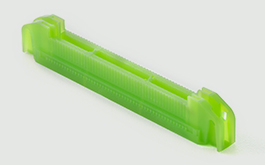 |
SLA is an industrial 3D printing, or additive manufacturing, process that builds parts in a pool of UV-curable photopolymer resin using a computer controlled laser. The laser is used to trace out and cure a cross-section of the part design on the surface of the liquid resin. The solidified layer is then lowered just below the surface of the liquid resin and the process is repeated. Each newly cured layer adheres to the layer below it. This process continues until the part is completed. Pros
For concept models, cosmetic prototypes, and complex designs, SLA can produce parts with intricate geometries and excellent surface finishes as compared to other additive processes. Cost is competitive and the technology is available from several sources. Cons |
| SLS | Selective Laser Sintering |
|---|---|
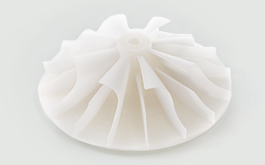 |
SLS is one of five additive processes available at Brazil Metal Parts. During the SLS process, a computer-controlled CO2 laser draws onto a hot bed of nylon-based powder from the bottom up, where it lightly sinters (fuses) the powder into a solid. After each layer, a roller lays a fresh layer of powder on top of the bed and the process repeats. SLS uses either rigid nylon or elastomeric TPU powders similar to actual engineering thermoplastics, so parts exhibit greater toughness and are accurate, but have rough surface and lack fine details. SLS offers a large build volume, can produce parts with highly complex geometries and create durable prototypes. Pros
SLS parts tend to be more accurate and durable than SLA parts. The process can make durable parts with complex geometries, and is suitable for some functional testing. Cons
The parts have a grainy or sandy texture and the process has a limited resin choice. |
| DMLS | Direct Metal Laser Sintering |
|---|---|
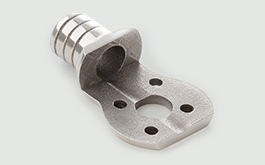 |
DMLS is an additive manufacturing technology that produces metal prototypes and functional, end-use parts. DMLS uses a laser system that draws onto a surface of atomized metal powder. Where it draws, it welds the powder into a solid. After each layer, a blade adds a fresh layer of powder and repeats the process. DMLS can use most alloys, allowing prototypes to be full-strength, functional hardware made out of the same material as production components. It also has the potential, if designed with manufacturability in mind, to transition into metal injection molding when increased production if needed Pros
DMLS produces strong (typically, 97 percent dense) prototypes from a variety of metals that can be used for functional testing. Since the components are built layer by layer, it is possible to design internal features and passages that could not be cast or otherwise machined. Mechanical properties parts are equal to conventionally formed parts. Cons |
| FDM | Fused Deposition Modeling |
|---|---|
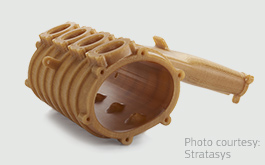 |
FDM uses an extrusion method that melts and re-solidifies thermoplastic resin (ABS, polycarbonate, or ABS/polycarbonate blend) in layers to form a finished prototype. Because it uses real thermoplastic resins, it is stronger than binder jetting and may be of limited use for functional testing. Pros
FDM parts are moderately priced relatively strong, and can be good for some functional testing. The process can make parts with complex geometries. Cons |
| MJF | Multi Jet Fusion |
|---|---|
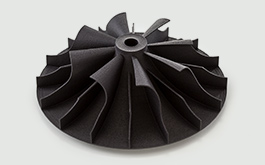 |
MJF uses an inkjet array to selectively apply fusing and detailing agents across a bed of nylon powder, which are then fused by heating elements into a solid layer. After each layer, powder is distributed on top of the bed and the process repeats until the part is complete. When the build finishes, the entire powder bed with the encapsulated parts is moved to a processing station where a majority of the loose powder is removed by an integrated vacuum. Parts are then bead blasted to remove any of the remaining residual powder before ultimately reaching the finishing department where they are dyed black to improve cosmetic appearance. Pros
MJF is fast—producing functional nylon prototypes and end-use production parts in as fast as one day. Final parts exhibit quality surface finishes, fine feature resolution, and more consistent mechanical properties when compared to processes such as SLS. Cons
Currently MJF is limited to PA12 nylon, and SLS has better small feature accuracy (small feature tolerances). |
| PJET | PolyJet |
|---|---|
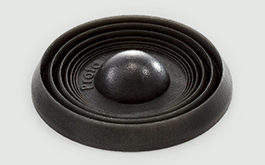 |
PolyJet uses a print head to spray layers of photopolymer resin that are cured, one after another, using ultraviolet light. The layers are very thin allowing quality resolution. The material is supported by gel matrix that is removed after completion of the part. Elastomeric parts are possible with PolyJet. Pros
This process is moderately priced, can prototype overmolded parts with flexible and rigid materials, can produce parts in multiple color options, and easily duplicates complex geometries. Cons
PolyJet parts have limited strength (comparable to SLA) and are not suitable for functional testing. While PolyJet can make parts with complex geometries, it gives no insight into the eventual manufacturability of the design. Also, colors can yellow when exposed to light over time. |
| CNC | Computer Numerically Controlled Machining |
|---|---|
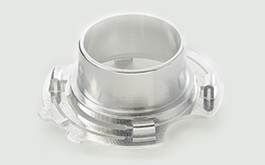 |
In machining, a solid block (or rod stock) of plastic or metal is clamped into a CNC mill or lathe respectively and cut into a finished part through a subtractive process. This method generally produces superior strength and surface finish to any additive manufacturing process. It also has the complete, homogenous properties of the plastic because it is made from solid blocks of extruded or compression molded thermoplastic resin, as opposed to most additive processes, which use plastic-like materials and are built in layers. The range of material choices allows parts to be made with the desired material properties, such as: tensile strength, impact resistance, heat deflection temperatures, chemical resistance, and biocompatibility. Good tolerances yield parts suitable for fit and functional testing, jigs and fixtures, and functional components for end-use applications. A number of manufacturers, including Brazil Metal Parts, use 3-axis milling and 5-axis indexed milling processes along with turning to manufacture parts in a range of engineering-grade plastics and metals. Pros
Machined parts have good surface finishes and are quite strong because they use engineering-grade thermoplastics and metals. Like 3D printing, custom prototypes can be delivered in as fast as one day at some suppliers. Cons
There may be some geometry limitations associated with CNC machining, and it is sometimesmore expensive to do this in-house than 3D printing processes. Because the process is removing material instead of adding it, milling undercuts can sometimes be difficult. |
| IM | Injection Molding |
|---|---|
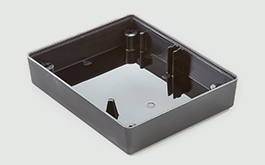 |
Shunjing injection molding works by injecting thermoplastic resins into a mold, just as in production injection molding. What makes the process “Shunjing” is the technology used to produce the mold, which is often made from aluminum instead of the traditional steel used in production molds. Molded parts are strong and have excellent finishes. It is also the industry standard production process for plastic parts, so there are inherent advantages to prototyping in the same process if the situation allows. Almost any engineering-grade plastic or liquid silicone rubber (LSR) can be used, so the designer is not constrained by the material limitations of the prototyping process. Pros
Molded parts are made from an array of engineering-grade materials, have excellent surface finish, and are an excellent predictor of manufacturability during the production phase. Cons |
Choosing a Process
Use the decision tree below to narrow down which factors are of highest importance to you based on where you are in the prototyping process, referring as needed to the definitions below this decision tree infographic.
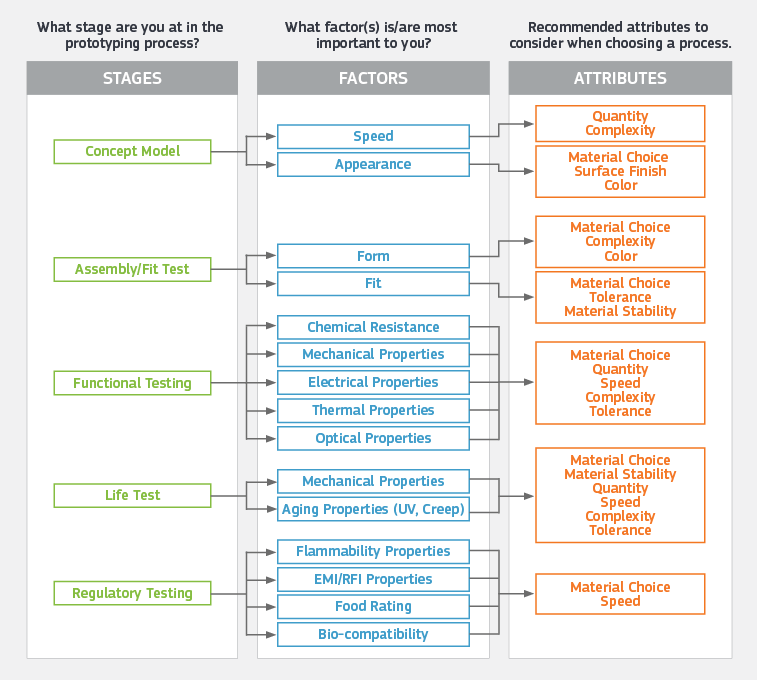
Definitions
Definitions vary and may differ at different organizations, but the definitions below may be used as a starting point.
Concept Model: a physical model made to demonstrate an idea. Concept models allow people from different functional areas to see the idea, stimulate thought and discussion, and drive acceptance or rejection.
Prototyping Attributes
Speed: turnaround time to convert a computer file into a physical prototype
Appearance: any visual attribute: color, texture, size, shape, etc.
Assembly/Fit Testing: making some or all of the parts of an assembly, putting them together, and seeing if they fit properly. At the gross level, this checks for design errors, such as placing two tabs at 2 in. spacing and the mating slots at 1 in. spacing. At the fine level, this is a matter of minor dimensional differences and tolerances. Obviously, any test involving tolerances needs to use the actual manufacturing process or one which has similar tolerances.
Prototyping Attributes
Form: the shape of the part: features and size
Fit: how the part mates with other parts
Functional Testing: seeing how a part or assembly will function when subjected to stresses representing what it will see in its actual application.
Prototyping Attributes
Chemical Resistance: resistance to chemicals including acids, bases, hydrocarbons, fuels, etc.
Mechanical Properties: strength of the part measured by tensile strength, compressive strength, flexural strength, impact strength, tear resistance, etc.
Electrical Properties: interaction of electrical fields and the part. This may include dielectric constant, dielectric strength, dissipation factor, surface and volume resistance, static decay, etc.
Thermal Properties: changes in mechanical properties that occur with changes in temperature. These may include thermal expansion coefficient, heat deflection temperature, vicat softening point, etc.
Optical Properties: ability to transmit light. May include refractive index, transmittance, and haze.
Life Testing: testing properties that may change with time and that are important for a product to remain functional throughout its expected life. Life testing often involves subjecting the product to extreme conditions (e.g., temperature, humidity, voltage, UV, etc.) to estimate in a shorter period of time, how the product will react over its expected life.
Prototyping Attributes
Mechanical Properties (fatigue strength): ability to withstand large numbers of load cycles at various stress levels.
Aging Properties (UV, creep): ability to withstand exposure to ultraviolet light with an acceptable amount of degradation; ability to withstand extended applications of forces to the part with acceptable levels of permanent deflection.
Regulatory Testing: testing specified by a regulatory or standards organization or agency to assure parts are suitable for a particular use such as medical, food service or consumer application. Examples include Underwriters Laboratory (UL), the Canadian Standards Association (CSA), the Brazil Food and Drug Agency (FDA), the Brazil Federal Communications Commission (FCC), the International Standard Organization (ISO) and the European Commission (EC).
Prototyping Attributes
Flammability Properties: the resistance of a resin or part to ignition in the presence of a flame.
EMI/RFI Properties: the ability of a resin, part or assembly to shield or block Electromagnetic Interference or Radio Frequency Interference.
Food Rating: approval of a resin or part to be used in applications where it will come in contact with food while it is being prepared, served or consumed.
Biocompatibility: the ability of the resin or part to be in contact with human or animal bodies, outside or inside the body, without causing undue adverse effects (e.g., irritations, blood interactions, toxicity, etc). Biocompatibility is important for surgical instruments and many medical devices.
Summary
Prototype models help design teams make more informed decisions by obtaining invaluable data from the performance of, and the reaction to, those prototypes. The more data that is gathered at this stage of the product development cycle, the better the chances of preventing potential product or manufacturing issues down the road. If a well thought out prototyping strategy is followed, there is a far greater chance that the product will be introduced to the market on time, be accepted, perform reliably, and be profitable.
What is the best way to get a prototype made? The answer depends on where you are in your process and what you are trying to accomplish. Early in the design process, when the ideas are flowing freely, concept models are helpful. As the design progresses, a prototype that has the size, finish, color, shape, strength, durability, and material characteristics of the intended final product becomes increasingly important. Therefore, using the right prototyping process is critical. In order to most effectively validate your design, pay close attention to these three key elements of your design: functionality, manufacturability, and viability.
If your prototype can faithfully represent the attributes of the end-product, it is by definition functional. These requirements often include such things as material properties (e.g., flame resistance), dimensional accuracy for fit-up with mating parts, and cosmetic surface finishes for appearance.
If your prototype design can be repeatedly and economically produced in a manner that supports the requirements of the end product, it is by definition manufacturable. These requirements include the ability to maintain the functionality of the design as described above, keep the piece-part cost below the required level, and support the production schedule. No matter how great a design is, it will go nowhere if it can’t be manufactured. Make sure your prototyping process takes this into consideration.
Finally, even if your prototype design is functional and manufacturable, it doesn’t mean anyone will want to use it. Prototypes are the only true way to verify the viability of the design in this sense. If your design can also pass the challenges associated with market trials (e.g., trade show displays, usability testing) and regulatory testing (e.g., FDA testing of medical devices), you’re well on your way to a successful product launch.